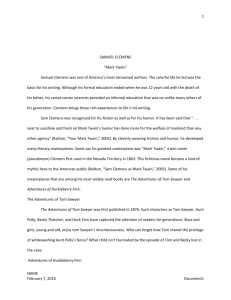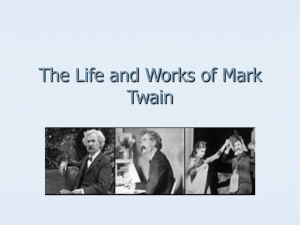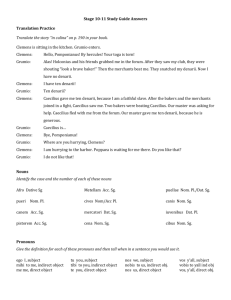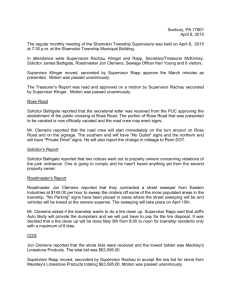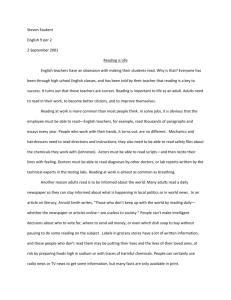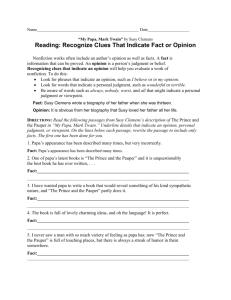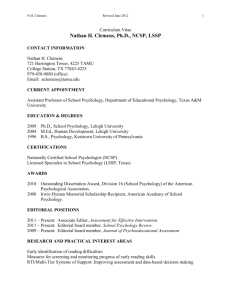20130830100486 - University School of Jackson
advertisement
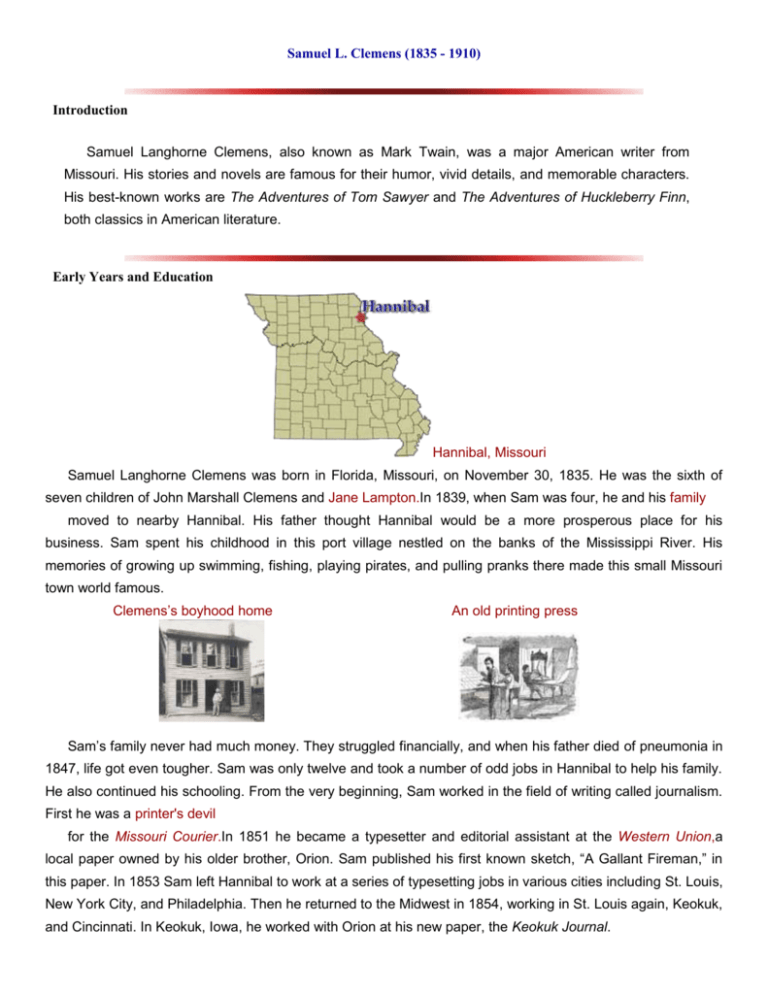
Samuel L. Clemens (1835 - 1910) Introduction Samuel Langhorne Clemens, also known as Mark Twain, was a major American writer from Missouri. His stories and novels are famous for their humor, vivid details, and memorable characters. His best-known works are The Adventures of Tom Sawyer and The Adventures of Huckleberry Finn, both classics in American literature. Early Years and Education Hannibal, Missouri Samuel Langhorne Clemens was born in Florida, Missouri, on November 30, 1835. He was the sixth of seven children of John Marshall Clemens and Jane Lampton.In 1839, when Sam was four, he and his family moved to nearby Hannibal. His father thought Hannibal would be a more prosperous place for his business. Sam spent his childhood in this port village nestled on the banks of the Mississippi River. His memories of growing up swimming, fishing, playing pirates, and pulling pranks there made this small Missouri town world famous. Clemens’s boyhood home An old printing press Sam’s family never had much money. They struggled financially, and when his father died of pneumonia in 1847, life got even tougher. Sam was only twelve and took a number of odd jobs in Hannibal to help his family. He also continued his schooling. From the very beginning, Sam worked in the field of writing called journalism. First he was a printer's devil for the Missouri Courier.In 1851 he became a typesetter and editorial assistant at the Western Union,a local paper owned by his older brother, Orion. Sam published his first known sketch, “A Gallant Fireman,” in this paper. In 1853 Sam left Hannibal to work at a series of typesetting jobs in various cities including St. Louis, New York City, and Philadelphia. Then he returned to the Midwest in 1854, working in St. Louis again, Keokuk, and Cincinnati. In Keokuk, Iowa, he worked with Orion at his new paper, the Keokuk Journal. The Cub Riverboat Pilot Becomes Mark Twain Steamboat on the Mississippi River In 1857, at the age of twenty-two, Sam Clemens boarded a steamboat and headed to New Orleans. He planned to take a trip to South America. Instead, he met the steamboat pilot Horace Bixby, who agreed to let Clemens train with him as a riverboat pilot for a fee of five hundred dollars. For the next two years, Clemens learned how to pilot a riverboat on the Mississippi River. He gained his piloting license in April 1859 and made a good living until the outbreak of the Civil War in April 1861 when all commercial traffic on the river stopped. Clemens then joined the Marion Rangers, a group of Confederate volunteers that disbanded after only two weeks. Clemens as a riverboat pilot In the summer of 1861, President Abraham Lincoln appointed Orion Clemens territorial secretary of Nevada. Sam joined his brother, and together they headed west by stagecoach. When they arrived in Nevada, Clemens worked for Orion for a while, but thought he could make a fortune mining for silver or gold. Though he tried to strike it rich, Clemens failed and returned to journalism, this time as a reporter. He joined the Virginia City Territorial Enterprisein 1862 and was paid $25 a week for various kinds of articles, both serious reports and humorous pieces. In 1863 he began signing his name with the pseudonym “Mark Twain,” a river term meaning “two fathoms deep.” Mark Twain would be Clemens’s pen name for the rest of his life. Literary Fame Mark Twain on the lecture circuit In 1864 Clemens moved to San Francisco and worked for various newspapers. When his short story “Jim Smiley and His Jumping Frog” was published and widely circulated in 1865 by the Saturday Press of New York, Mark Twain became a nationally known humorist. He gave his first public lecture in October 1866 and embarked on a lecture tour in the western states to make money and promote his career. Clemens had a natural talent for telling stories and making speeches. He would lecture on and off for the rest of his life. Clemens's house in Hartford In 1867, Clemens set sail as a traveling correspondent on a grand tour of Europe and the Mideast for the San Francisco Alto California. His reports of this journey later became his first best-selling book, Innocents Abroad,published in 1869. After this journey, Clemens met Olivia Langdonof Elmira, New York. They married in 1870 and soon settled in Hartford, Connecticut. Together they had four children: a son, Langdon, who died as an infant, and three daughters—Susy, Clara, and Jean. Tom Sawyer and Huck Finn It was at their house in Hartford that Clemens turned from journalism to writing the books and novels that made him famous. In 1872 he published Roughing It, an autobiographical account of his years in the West. He published The Adventures of Tom Sawyerin 1876 and his masterpiece, The Adventures of Huckleberry Finn,in 1884. Clemens set both of these novels in his native Missouri and drew heavily on his boyhood memories of growing up in Hannibal. He examined American culture on the edge of the frontier and dealt seriously with such issues as slavery, poverty, and class differences. Clemens’s natural wit and keen observations of human nature—developed and perfected during his years as a journalist—found full expression in his fiction. Failures and Losses Mark Twain in 1890 Despite his great literary successes, Samuel Clemens was unlucky in business. He had a strong, recurrent desire to invest in products and projects that often failed, such as the Paige typesetter, an automatic typesetting machine. In fact, Clemens did much of his writing and lecturing to pay off his debts. He and his family moved to Europe in 1891 to live more cheaply and to improve his wife’s health. Then in 1896, Clemens suffered the first of a series of devastating personal losses. While he was lecturing in England, Clemens’s daughter Susy died of spinal meningitis. During the next decade, Clemens would suffer the loss of his wife, Livy, in 1904 and his second daughter, Jean, in 1909. Clemens's Legacy Clemens at the University of Missouri Samuel Clemens returned to the United States in 1900. He was greeted by a supportive public that admired his work. In 1902 he traveled to Missouri for the last time to accept an honorary degree from the University of Missouri in Columbia. While in his home state, Clemens also visited St. Louis and returned to Hannibal. There he took a short trip on the Mississippi River with his old friend and instructor Horace Bixby. Mark Twain The writings of Mark Twain endure on bookshelves and in the hearts and minds of readers around the world. In his sketches, articles, stories, and novels, he captured the flavor and spirit of America during the late nineteenth century. More importantly, he wrote eloquently about universal themes that affect people of all times. His wit, combined with a deep sympathy for innocent and well-meaning people, came from his humble origins in Missouri. Clemens died at Stormfield on April 21, 1910, at the age of 74. He is buried in Woodlawn Cemetery in Elmira, New York, next to his wife and children. His pen name lives on in his books, in an annual book award, and in the vast national forest in Missouri that is named in his honor.
